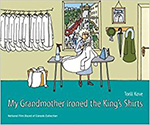My Grandmother Ironed the King's Shirts by T. Kove
DOI:
https://doi.org/10.20361/G2PD7NAbstract
Kove, Torill. My Grandmother Ironed the King's Shirts. Firefly Books, 2017.
My Grandmother Ironed the King’s Shirts is based on Torill Kove’s Academy Award nominated short film of the same title. The book is Kove’s retelling of one of her grandmother’s stories. This book is a fictional story set in a historical period.
It is about Norway’s first king in hundreds of years. Following the introduction of the King, it becomes immediately clear that this is a fictional story. The story explains that the new King’s public reputation was harmed by his inability to iron his own clothing. In reality, the King of Norway would have likely had staff to do this. Fortunately, after his first disastrous public appearance in wrinkled clothes, he found a store that was willing to do his family’s ironing. Kove’s grandmother worked at the store and soon realized that the clothes she was ironing belonged to the King. She proudly told everyone that she ironed the king’s clothes, up until the King was forced to flee Oslo during the Second World War. When the Germans invaded, Kove’s grandmother was tasked with cleaning and pressing their uniforms. She decided to join the Norwegian Resistance by sabotaging their uniforms. All of Norway’s shirt pressers joined the movement and in 1945, when the Germans left, they had to do so without clothes.
The illustrations in this book are simple line work filled in with solid colours. They are drawn in a comical cartoonish manner and all were pulled from the original short animated film. Pre-war, the images are dominated with brighter colours and they fill the entire page. During the war, the images are smaller, only occupying parts of the pages, with a white background dominating. The illustrations were all pulled from the original short film, where the images always filled the screen, which makes this change to the small images from full-page illustrations seem like it serves no clear purpose.
While this story provides a historical setting, and might encourage an interest in history, it may cause confusion in children because it is presented as historical while in reality it is overwhelmingly fictitious. It also makes use of the term “gypsy” which may have been appropriate in the historical period presented in the story, but is now considered a derogatory term (the preferred term is “Roma” or “Romani”) and therefore I would not recommend it for school libraries. That said, it is a quirky and fun story for elementary aged children that communicates a message of strength in adversity. As a result, I would recommend it for public libraries.
Editor’s note: One of three new titles in the Firefly Books-National Film Board of Canada partnership.
Recommended: 3 stars out of 4
Reviewer: Laura Hamonic
Laura Hamonic is an Academic Library Resident at the University of Alberta’s Science and Technology Library. She has a passion for all things crafty and spends her days cross stitching, crocheting, and costume making.

Published
How to Cite
Issue
Section
License
Authors who publish with this journal agree to the following terms:
- Authors retain copyright and grant the journal right of first publication with the work simultaneously licensed under a Creative Commons Attribution License that allows others to share the work with an acknowledgement of the work's authorship and initial publication in this journal.
- Authors are able to enter into separate, additional contractual arrangements for the non-exclusive distribution of the journal's published version of the work (e.g., post it to an institutional repository or publish it in a book), with an acknowledgement of its initial publication in this journal.
- Authors are permitted and encouraged to post their work online (e.g., in institutional repositories or on their website) prior to and during the submission process, as it can lead to productive exchanges, as well as earlier and greater citation of published work (See The Effect of Open Access).






